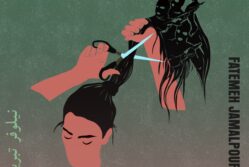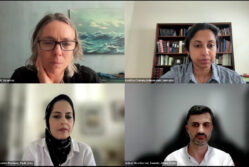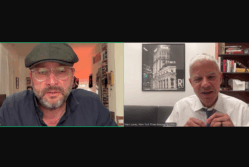Event Coverage Highlight

‘How to Save the Amazon’ Honors Dom Phillips’ Legacy and Seeks Solutions for Deforestation
by Chad Bouchard
British journalist Dom Phillips reported on deforestation in the Brazilian Amazon forest for several years before he was shot and killed during a trip in 2022, along with Bruno Pereira, an activist and expedition leader. Phillips left behind an unfinished manuscript and extensive notes, which journalist friends and family spent three years completing.
On June 9, the OPC co-sponsored a book night with the Rizzoli Bookstore to celebrate the U.S. launch of the book, titled How to Save the Amazon: A Journalist’s Fatal Quest for Answers, with Phillips’ wife, Alessandra Sampaio, and Intercept Brazil co-founder Andrew Fishman, who was among the 36 writers and contributors who finished the project. Matthew Hay Brown, Americas editor for The Washington Post, served as moderator.
“Dom was a guy – amazing, lovely, handsome guy – who was very connected with nature. This is quite important to say, because he saw nature as not something apart from him,” Sampaio said. “He was the kind of journalist that cares not just about the information, but about people, and about their stories.”
Sampaio said the book sets out to find practical solutions to deforestation, and focuses on the perspectives of Indigenous people and longtime activists.
“We have to listen to people from the Amazon. We have to listen to people that protect the Amazon. They are in the center of the discussion,” she said. “We have many solutions created outside the Amazon by governments, but I don’t know many discussions with people who live there.”
She added that the team of contributors each brought their own voices and additional reporting to the finished book.
“All of them had their own style of writing, and I think this is so beautiful,” she said. “This is fantastic, because it’s Dom’s vision running through the collaborative work.”
Fishman warned that the disappearance of the Amazon rainforest could lead to a far-reaching ecological disaster.
“The Amazon is at the very edge of a tipping point. This is a scientific consensus. We don’t know exactly when it’s going to be, or what it will look like, but there’s a point of no return where you’ve deforested enough of the Amazon that it can’t create the water cycle, so it can’t replenish itself.”
He said if that happens, there would be collateral effects all over the rest of the world, from mass displacement of populations to the acceleration of harmful climate effects in other regions.
“São Paulo, the biggest city in South America, already has trouble with its own water supply. You can imagine what would happen if the source of that water disappears, he said. “How many hundreds of millions of people are going to be trying to flee South America? We know the Amazon is not isolated by itself. There are many other global climate tipping points happening around the world right now. If the Amazon tips, then those are all going to tip much faster and much harder.”
Brown asked Fishman about the role of Indigenous communities, which are often exploited by corporations, politicians and criminal gangs in ways that worsen deforestation. Fishman said any solutions would have to take local communities into account. He said those communities need to have alternatives to the funding they can get for harmful industries like logging or mining.
“There are millions of people in the Amazon that are ready to participate in the solution, if you can work with them to help.”
Click on these links to purchase the book at the Rizzoli Bookstore or on Bookshop.org.
Click the window below to watch a playlist of video clips from the program.



